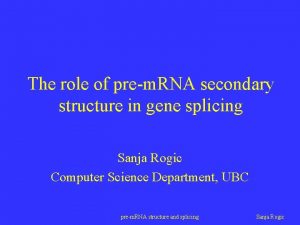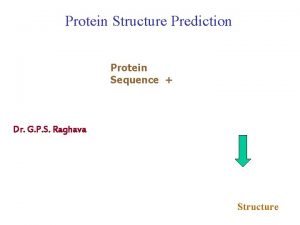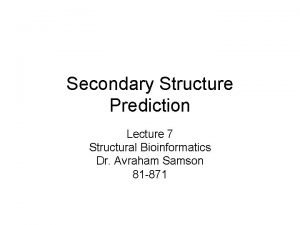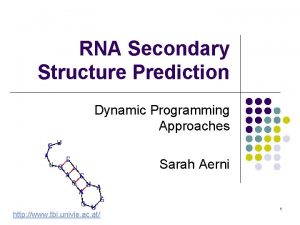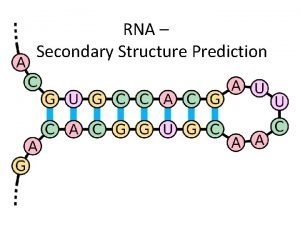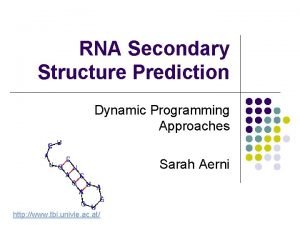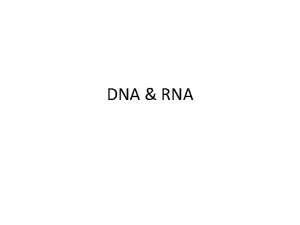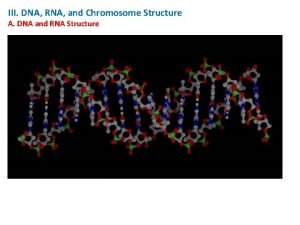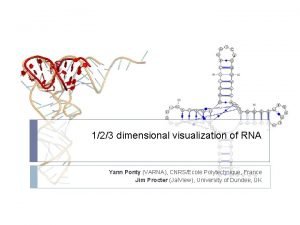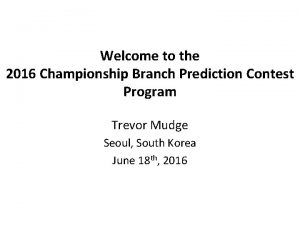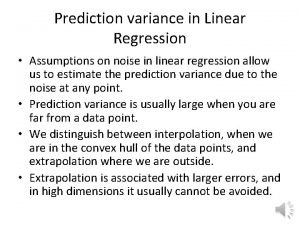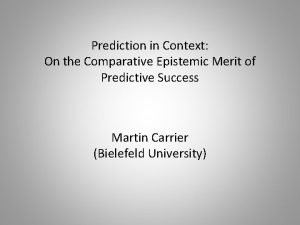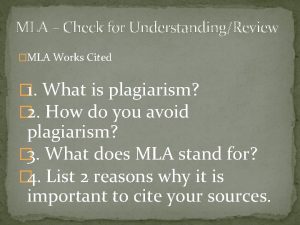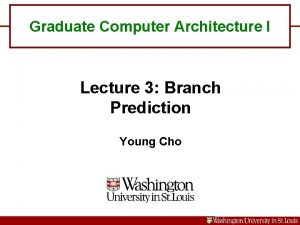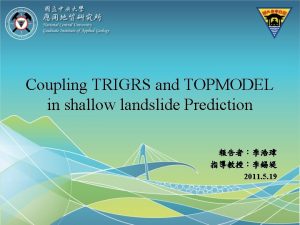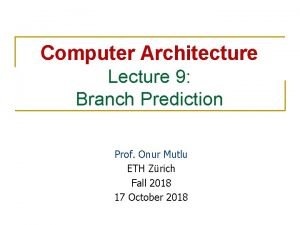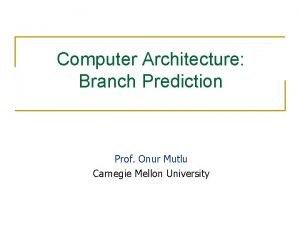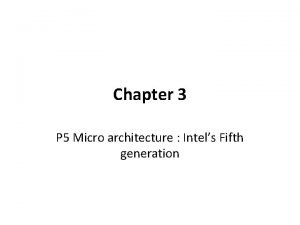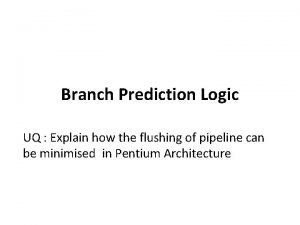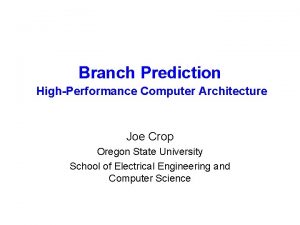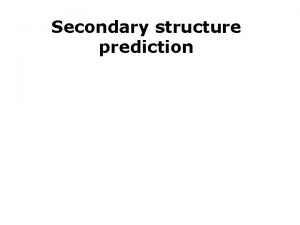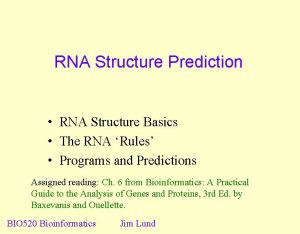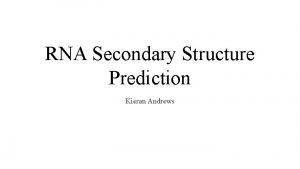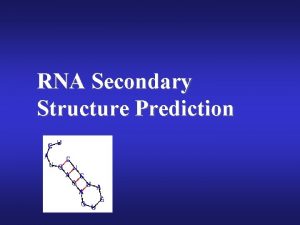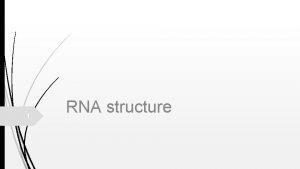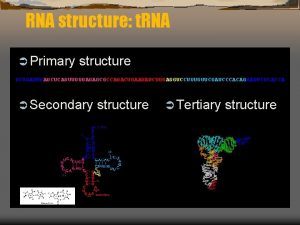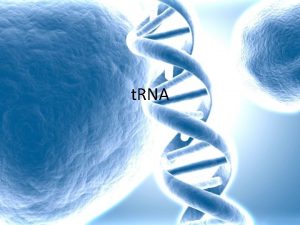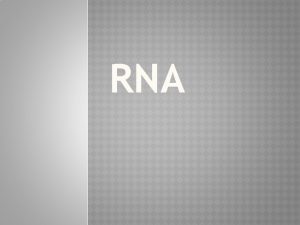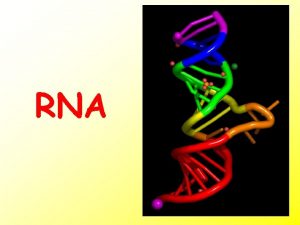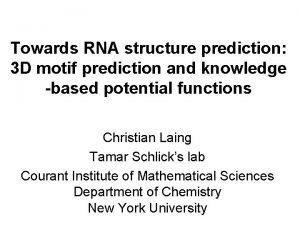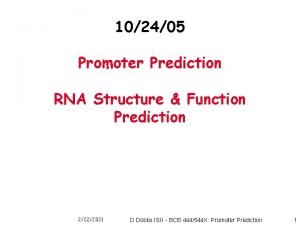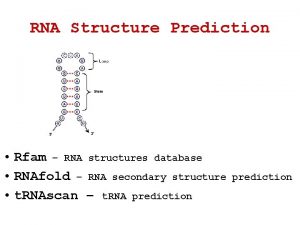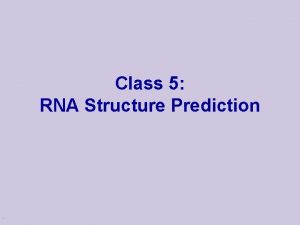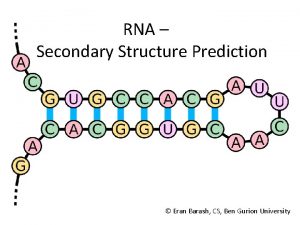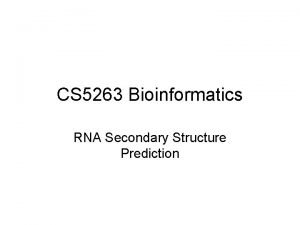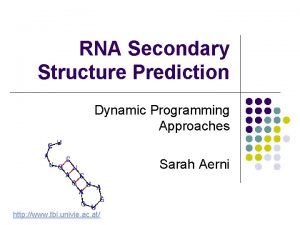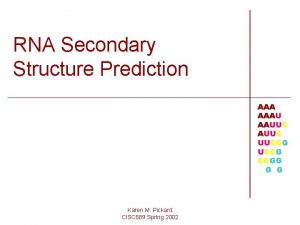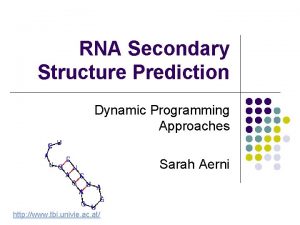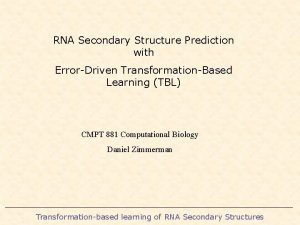RNA Secondary Structure Prediction Introduction RNA is a




































- Slides: 36

RNA Secondary Structure Prediction Introduction • RNA is a single-stranded chain of the nucleotides A, C, G, and U. The string of nucleotides specifies the linear structure of the RNA strand. • When RNA folds, complementary nucleotides form base pairs (CG and AU). • The tertiary (3 dimensional) structure is too complicated for us to calculate. • We calculate only secondary structures, lists of base pairs. • Knowing the base pairs tells a lot about the 3 dimensional structure.

Chemical Structure of RNA • Four base types. • Distinguishable ends.

Partial Tertiary Structure • One illustration

Yet Another Tertiary Structure • Found via google

Our Final Tertiary Picture • Very complex

A Partial RNA Secondary Structure

Pure Secondary Structure

Our Basic Model • RNA linear structure: R=r 1 r 2. . . rn from {A, C, G, U} • RNA secondary structure: pairs (ri, rj) such that 0<i<j<n+1. • Goal: secondary structures with minimum free energy.

Implementing Model Restrictions • No knots: pairs (ri, rj) and (rk, rl) such that i<k<j<l. RNA does contain knots. • Program loop structure. • No “close” base pairs: j-i>t for some t>0. • High free energy. • Complementary base pairs: A-U, C-G. • High free energy.

Our Two Algorithms • Independent base pairs – quite easy, but inaccurate. • Calculate loops’ free energy – best we can do for today’s class.

Independent Base Pair Algorithm • Assumption: Independent base pairs. • Advantage 1: Simpler calculations. • Advantage 2: Illustrates ideas for a much more accurate algorithm. • Disadvantage: Unrealistic answers.

Independent Base Pairs What Makes It “Easy”? • Assumption: The energy of each base pair is independent of all of the other pairs and the loop structure. • Consequence: Total free energy is the sum of all of the base pair free energies.

Independent Base Pairs Basic Approach • Use solutions for smaller strings to determine solutions for larger strings. • This is precisely the kind of decoupling required for dynamic programming algorithms to work.

Independent Base Pairs Notation • a(ri, rj) – the free energy of a base pair joining ri and rj. • Si, j – The secondary structure of the RNA strand from base ri to base rj. Ie, the set of base pairs between ri and rj inclusive. • E(Si, j) – The free energy associated with the secondary structure Si, j. • We define a(ri, rj) large when constraints are violated.

Independent Base Pairs: Calculating Free Energy • Consider the RNA strand from position i to j. • Consider whether rj is paired • If rj is paired, E(Si, j)=E(Si, k-1)+a(k, j)+E(Sk+1, j-1) for some i-1<k<j • If rj isn’t paired, then E(Si, j)=E(Si, j-1)

Independent Base Pairs - Algorithm • We search for intervals with minimum free energy. • For each interval, the free energy is given by this formula: E(Si, j) = min( E(S i+1, j-1)+a(ri, rj), E(S i, k-1+a(ri, rk)+Sk+1, j-1), i -1<k<j+1 ) • The free energy of the RNA strand is E(S 1, n).

Independent Base Pairs: Question 1 • How does this formula deal with the case where rj isn’t paired with any base? • A special case of E(Si, k-1+a(ri, rk)+Sk+1, j-1), i -1<k<j+1 • The special case with k=j.

Independent Base Pairs: Question 2 • What is the high level algorithm flow? 1. Advance from smaller to larger intervals, calculating free energy costs. 2. Trace back the path that corresponds to the maximum free energy cost.

Independent Base Pairs: Question 3 • In what orders can the intervals’ free energy costs be evaluated? 1. 2. 3. 4. Major = lower, minor = upper bound Major = upper, minor = lower bound Diagonally Any order (eg, random) that respects the partial order induced by inclusion

Independent Base Pairs: Question 4 • What are the time and storage requirements of this algorithm? • Express your answer in terms of the number of bases in the RNA strand. • Since the number of intervals is quadratic, the storage requirements are quadratic. • Since the time requirement for each interval is linear, total time is cubic.

Independent Base Pairs: Question 5 • Why not simply calculate free energies as they are needed? Why store them at all? • Because the recursive calls would turn our polynomial algorithm into an exponential algorithm.

Independent Base Pairs: Question 6 • How does traceback work for this algorithm? 1. Recalculate which subinterval yields the maximum free energy. 2. Save traceback paths.

Loop Free Energy Algorithm • An RNA molecule’s free energy is not independent of all other base pairs. • An RNA molecules free energy actually depends on its loop structure. • What do we mean by loops?

Types of Loops • Each base pair (ri, rj) encloses a loop: 1. Hairpin loop 2. Bulge on i or j 3. Interior loop 4. Helical region

Hairpin Loop • There are no base pairs (rk, rl) for i<k<l<j.

Bulge on i and j • Bulge on i: • (ri, rj) and (rk, rj-1) are base pairs with k>i+1. • ri+1 is not paired. • The bulge on j is symmetric.

Interior loop • (ri, rj) and (rk, rl) are base pairs with i+1<k 2<j-1. • ri+1 and rj-1 are not in base pairs

Helical region • (ri, rj) and (ri+1, rj-1) are base pairs.

Free energy analysis • E(Si, j) = E(Si+1, j) when ri isn’t paired. • E(Si, j) = E(Si, j-1) when rj isn’t paired. • E(Si, j) = min(E(Si, k)+E(Sk+1, j)) for i<k<l, k between i’s and j’s pairs when i and j are paired but not to each other • E(Si, j) = E(Li, j) where Li, j is loop energy when I and j are paired to each other

Free Energy Functions • a(ri, rj) – Free energy of base pair (ri, rj) • H(k) – Destabilizing free energy of a hairpin loop with size k. • R – Stabilizing free energy of adjacent base pairs (helical region). • B(k) – Destabilizing free energy of a bulge of size k. • I(k) – Destabilizing free energy of an interior loop of size k.

Loop Energy Formulas • • • H(j-i-1) – for a hairpin loop R + E(S ) – for a helical region B(k) + E(S ) – for a bulge on i B(k) + E(S ) – for a bulge on j I(k 1+k 2) + E(Si+k 1+1, j-k 2 -1) – for an interior loop i+1, j-1 i+k+1, j-1 i+1, j-k-1

Free Energy Calculation for interval (i, j) • 1. 2. • • Minimize over Case where (r , r ) is not a pair. Case where (r , r ) is a pair. Add a(ri, rj) to the formulas. Minimize over k, k 1, and k 2. i j

What is the Apparent Complexity? • The interior loop calculations are given by I(k 1+k 2) + E(Si+k 1+1, j-k 2 -1) • The number of inner loop possibilities is quadratic in the interval size. • The number of intervals is quadratic in the size of the problem. • The complexity appears to grow as n 4.

What is the Actual Complexity? • Overall reduction from n 4 to n 3 is possible. • Interval reduction from n 2 to linear. • Store the minimum free energy V where the interval (i, j) contains an interior loop of size k. i, j, k

Multiple Solutions • Care must be taken to define the issues. • Multiple solutions can be obtained by adding flexibility to the traceback logic. • The number of solutions can grow exponentially.

References • M. Zuker, “The Use of dynamic programming in RNA secondary structure prdiction”. In M. S. Waterman, editor, Mathematical Methods for DNS Sequences. Boca Raton, FL: CRC Press, 1989 • J, Setubal and J. Meidanis, Ch 8. 1, Introduction to Computational Molecular Biology, Pacific Grove, CA: Brooks/Cole Publishing Co. , 1997
 Rna secondary structure prediction
Rna secondary structure prediction Rna secondary structure prediction
Rna secondary structure prediction Phd secondary structure prediction
Phd secondary structure prediction Canonical base
Canonical base Rna secondary structure
Rna secondary structure Rna secondary structure dynamic programming
Rna secondary structure dynamic programming Introduction paragraph structure
Introduction paragraph structure Dna rna
Dna rna Chromosome organization
Chromosome organization Varna rna structure
Varna rna structure Mention two defects of present curriculum
Mention two defects of present curriculum Will may might for predictions
Will may might for predictions Championship branch prediction
Championship branch prediction Corner prediction
Corner prediction Hunger games chapter 13 questions and answers
Hunger games chapter 13 questions and answers Variance in regression
Variance in regression Merit prediction
Merit prediction Singkong prediction
Singkong prediction Make a prediction about kenny and franchesca
Make a prediction about kenny and franchesca Good readers making predictions by
Good readers making predictions by How to make a prediction on a scatter plot
How to make a prediction on a scatter plot Fb24 prediction
Fb24 prediction Kelebihan dan kekurangan proyeksi silinder
Kelebihan dan kekurangan proyeksi silinder Hypothesis vs prediction
Hypothesis vs prediction Branch prediction in computer architecture
Branch prediction in computer architecture Demographic parity
Demographic parity Masta prediction
Masta prediction Branch prediction in computer architecture
Branch prediction in computer architecture Branch prediction in computer architecture
Branch prediction in computer architecture Branch prediction
Branch prediction Eye punnett square
Eye punnett square Residual standard deviation
Residual standard deviation Instruction issue algorithm of pentium processor
Instruction issue algorithm of pentium processor How to calculate sst in regression
How to calculate sst in regression Prediction%20cfa
Prediction%20cfa What is branch prediction logic
What is branch prediction logic Branch prediction in computer architecture
Branch prediction in computer architecture
